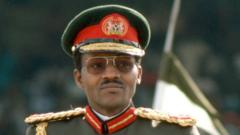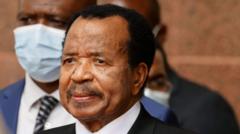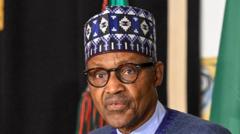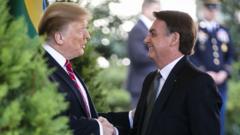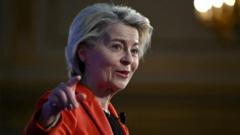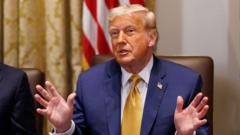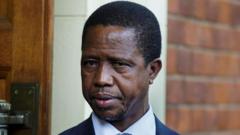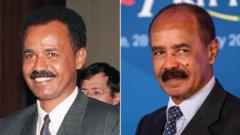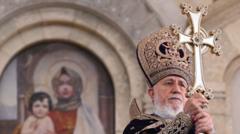Cardinal electors began the papal conclave in the Sistine Chapel to choose a successor to Pope Francis, marking a significant moment for the Roman Catholic Church amid pressing issues regarding its future direction and unity.
Papal Conclave Underway: Cardinals Face Critical Decisions for Church's Future

Papal Conclave Underway: Cardinals Face Critical Decisions for Church's Future
The Vatican prepares for a historic conclave as 133 cardinals gather to elect a new pope following the death of Pope Francis, amid a backdrop of deep divisions within the church.
The article text:
Vatican City is abuzz as today marks the commencement of a pivotal conclave where 133 voting cardinals are set to gather in the iconic Sistine Chapel to elect the next pope, following the recent death of Pope Francis just over two weeks ago. This conclave stands out as it witnesses the largest number of cardinals participating in history, setting the stage for potential shifts in direction for the 1.4 billion Catholics worldwide.
In an atmosphere thick with anticipation, cardinals participated in a solemn Mass at St. Peter's Basilica earlier today. The proceedings, which began with this spiritual invocation, will continue as the cardinals transition to the Sistine Chapel to begin casting their ballots at approximately 4:30 p.m. local time (10:30 a.m. Eastern), committing to a strict code of silence and confidentiality throughout the deliberations.
Underneath the revered frescoes, the conclave is expected to address the stark ideological divide that has characterized the church during Francis’s papacy. Progressives advocate for inclusivity and modernization, while more traditional factions resist such changes, emphasizing a return to the church's historic configurations.
This papal election is seen as a referendum on Francis's legacy—will the next leader continue his open, inclusive approach, or will they drive the church into a conservatively traditionalist era? Homilies delivered prior to the voting underscore the significance of the selection amid turbulent times for the church, including challenges related to financial transparency and historical reckonings surrounding sexual abuse scandals.
The cardinals will engage in multiple voting rounds, continuing until a candidate garners two-thirds majority approval, with expectations of potential delays given the complex considerations at hand. Historically, the last two conclaves concluded within two days, yet many analysts speculate this process could extend longer due to the dynamic and relatively unfamiliar makeup of the electors.
Among the leading candidates discussed in the lead-up to the conclave are Cardinal Pietro Parolin, seen as a moderate due to his significant roles within the Vatican under Francis, and Cardinal Luis Antonio Tagle, often referred to as the "Asian Francis" for supporters who pair his progressive ideals with charismatic outreach to developing communities.
As the cardinals prepare for their crucial voting, many are grappling with questions about their collective identity and the church's roles moving forward, which may hinge upon whether they aim to carry on the transformative initiatives put forth during Pope Francis’s momentous tenure or to revert to a more traditionally conservative path.
This critical moment for the Catholic Church will be closely monitored around the globe, signified by the smoke signals from the Sistine Chapel chimney, which will announce the outcome of the conclave once a new pope is elected. As the world watches and waits, this conclave symbolizes not just a change in leadership but a decisive turning point in the ongoing narrative of the Catholic Church's future.
Vatican City is abuzz as today marks the commencement of a pivotal conclave where 133 voting cardinals are set to gather in the iconic Sistine Chapel to elect the next pope, following the recent death of Pope Francis just over two weeks ago. This conclave stands out as it witnesses the largest number of cardinals participating in history, setting the stage for potential shifts in direction for the 1.4 billion Catholics worldwide.
In an atmosphere thick with anticipation, cardinals participated in a solemn Mass at St. Peter's Basilica earlier today. The proceedings, which began with this spiritual invocation, will continue as the cardinals transition to the Sistine Chapel to begin casting their ballots at approximately 4:30 p.m. local time (10:30 a.m. Eastern), committing to a strict code of silence and confidentiality throughout the deliberations.
Underneath the revered frescoes, the conclave is expected to address the stark ideological divide that has characterized the church during Francis’s papacy. Progressives advocate for inclusivity and modernization, while more traditional factions resist such changes, emphasizing a return to the church's historic configurations.
This papal election is seen as a referendum on Francis's legacy—will the next leader continue his open, inclusive approach, or will they drive the church into a conservatively traditionalist era? Homilies delivered prior to the voting underscore the significance of the selection amid turbulent times for the church, including challenges related to financial transparency and historical reckonings surrounding sexual abuse scandals.
The cardinals will engage in multiple voting rounds, continuing until a candidate garners two-thirds majority approval, with expectations of potential delays given the complex considerations at hand. Historically, the last two conclaves concluded within two days, yet many analysts speculate this process could extend longer due to the dynamic and relatively unfamiliar makeup of the electors.
Among the leading candidates discussed in the lead-up to the conclave are Cardinal Pietro Parolin, seen as a moderate due to his significant roles within the Vatican under Francis, and Cardinal Luis Antonio Tagle, often referred to as the "Asian Francis" for supporters who pair his progressive ideals with charismatic outreach to developing communities.
As the cardinals prepare for their crucial voting, many are grappling with questions about their collective identity and the church's roles moving forward, which may hinge upon whether they aim to carry on the transformative initiatives put forth during Pope Francis’s momentous tenure or to revert to a more traditionally conservative path.
This critical moment for the Catholic Church will be closely monitored around the globe, signified by the smoke signals from the Sistine Chapel chimney, which will announce the outcome of the conclave once a new pope is elected. As the world watches and waits, this conclave symbolizes not just a change in leadership but a decisive turning point in the ongoing narrative of the Catholic Church's future.




